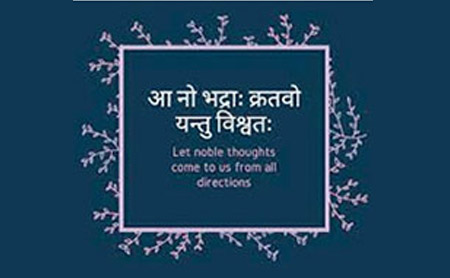
The word संस्कृत (Sanskrit) means polished or refined. It is allied to words like संस्कृति (Sanskriti), meaning culture or civilization, and संस्कार (samskar), meaning purification ceremony or sacrament.
Most Indian languages, in greater or lesser degree, trace their roots in Sanskrit. In that sense, more than a mother tongue, Sanskrit is a grandmother tongue.
Indeed, that influence extends beyond the boundaries of today’s India, to elsewhere in Asia. Nepal’s motto is जननी जन्मभूमिश्च स्वर्गादपी गरीयसी (Janani Janma Boomish cha Swargadapi Gareeyasi). This is taken from the ancient epic Ramayana written by Sage Valmiki and means, “The mother and the mother-land are superior to heaven.”
The name of the national airline of Indonesia is Garuda, which is a Sanskrit word. In Sanskrit, Garuda is the name of a bird more popularly known as the carrier of Bhagwan Vishnu. The name of Bangkok airport in Thailand is: “Swarna Bhoomi”, when translated to English means – land of gold. There are several such instances in South Asia and South East Asia.
To understand the exalted status of Sanskrit, it would be better to know what Justice Kuldeep Singh of the Supreme Court had to say in 1994 while delivering a judgment that was related to the teaching of Sanskrit in schools run by the government. “Learning of Sanskrit is undoubtedly necessary to protect our heritage. The stream of our culture would get dried up is we were to discourage the study of Sanskrit. Without the learning of Sanskrit, it is not possible to decipher the Indian philosophy on which our culture and heritage are based.”
A prominent scholar, an authority on various languages and a recipient of the Padma Bhushan award Dr. Lokesh Chandra said: “Sanskrit is the thread on which the pearls of the necklace of Indian culture are strung; break the thread and all the pearls will be scattered, even lost forever.”
Anglo-Welsh philologist Sir William Jones in 1786-called Sanskrit “a language more perfect than Greek, more copious than Latin, and more exquisitely refined than either.”
Popular Indian-American author Rajiv Malhotra of the Infinity Foundation spells out in his book, “The Battle for Sanskrit”, what is at stake for Sanskrit:
Some films also have been made in Sanskrit such as “Adi Shankaracharya”, “Bhagavad Gita” and “Mudrarakshasa”. In 2019, we will have an animated film in Sanskrit, crowd-funded and crowd-sourced, titled “Punyakoti”. Today we all might have been talking to each other in Sanskrit if the decision to making Sanskrit as a national language had not been lost by JUST ONE VOTE in the India’s Constituent Assembly after our independence. Today, there are seven villages in India who speak Sanskrit. As a language, Sanskrit is as easy or as difficult to learn and use as our mother tongue.
Some MRI scans show that memorizing ancient Sanskrit mantras increases the size of brain regions associated with cognitive function. Neuroscience shows how rigorous memorizing can help the brain. The term the ‘Sanskrit Effect’ was coined by neuroscientist James Hartzell, who studied 21 professionally, qualified Sanskrit Pundits. He discovered that memorizing Vedic mantras increases the size of brain regions associated with cognitive function, including short and long-term memory. This finding corroborates the beliefs of the Indian tradition, which holds that memorizing, and reciting mantras enhances memory and thinking.
As of now, India has a listing/digitization of three million manuscripts and the estimated stock of manuscripts in India is 35 million. There are at least 60,000 manuscripts in Europe and another 150,000 elsewhere in South Asia. Ninety-five per cent of these manuscripts have never been listed, collated or translated. A vast pool of our Sanskrit treasures are still not readable by common person due to un-translated reasons.
If we think of all the literature available in this linguistic system, it would be a vast treasury useful not only to India, but to the whole world: from the Vedas, the Vedangas, the Epics, the Kavya; poetics, literature, drama, science, philosophy, aesthetics, indeed the endless knowledge in nearly all branches of human endeavor available in Sanskrit makes it a unique repository, the world’s heritage language.
In fact, Sanskrit is conducive to all the four “Purushartha” or cardinal aims of life viz., Dharma, Artha, Kama, and Moksha, with its vast repositories of knowledge and guidance in each of these realms. Without Sanskrit, the fullest development of the human mind was almost unthinkable.
Sanskrit is also the great unifying force in India, knitting a vast subcontinent from Kashmir to Kanyakumari and Saurashtra to Kamarupa. It was only Sanskrit that could play the role of unifying India: “This great inheritance of Sanskrit is the golden link joining up all the various provincial languages and literatures and cultures, and it should not be allowed to be neglected and to go waste.”
The wonder that Sanskrit was for the entire world has been best described loudly by William James Durant, an American historian and philosopher, who had to say while writing about India: “India was the motherland of our race and Sanskrit the mother of Europe’s languages. India was the mother of our philosophy, mother, through the Arabs, of much of our mathematics; mother through the Buddha, of the ideals embodied in Christianity; mother through the village community, of self-government and democracy. In many ways, Mother India is the mother of us all.”
Jai Ho!